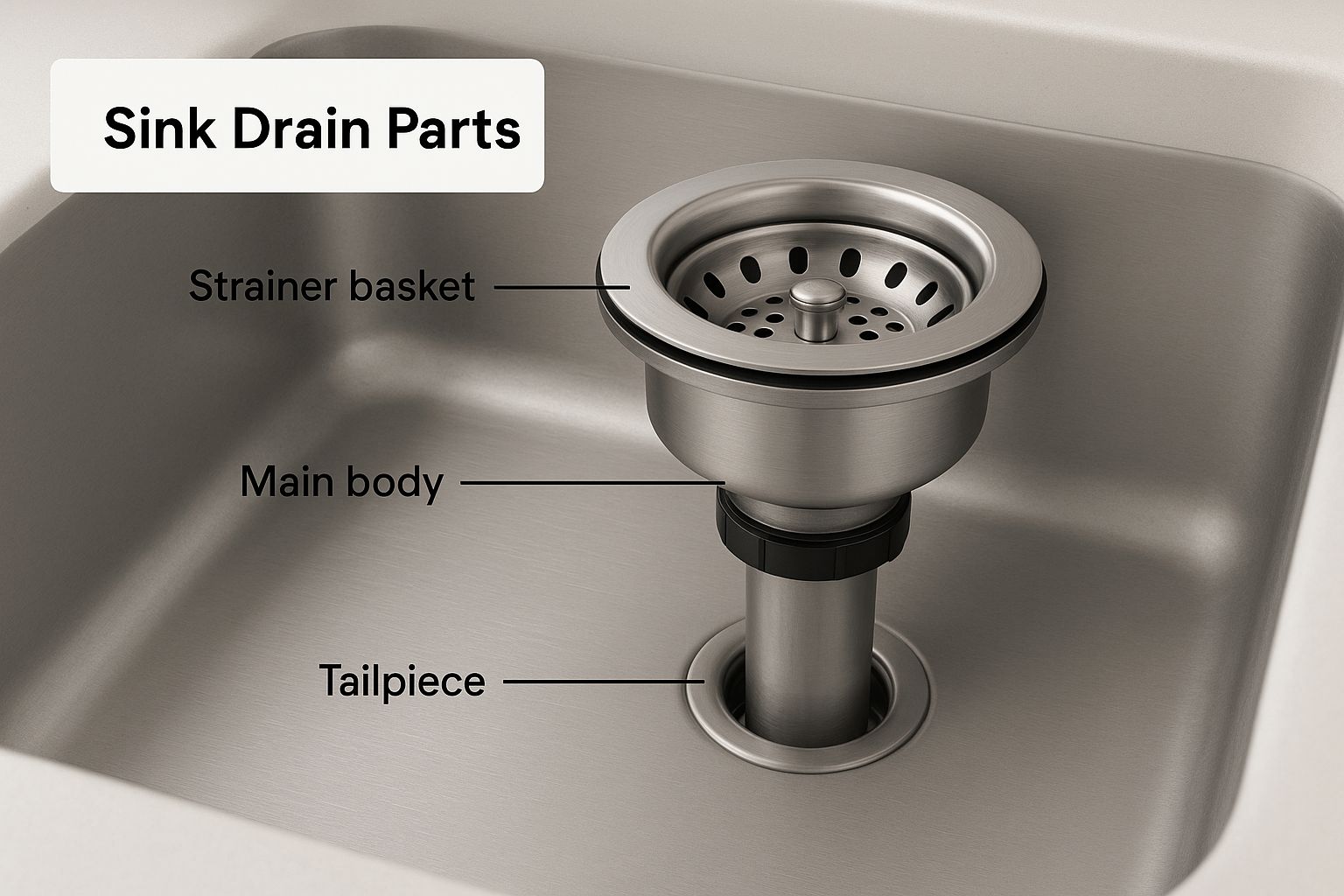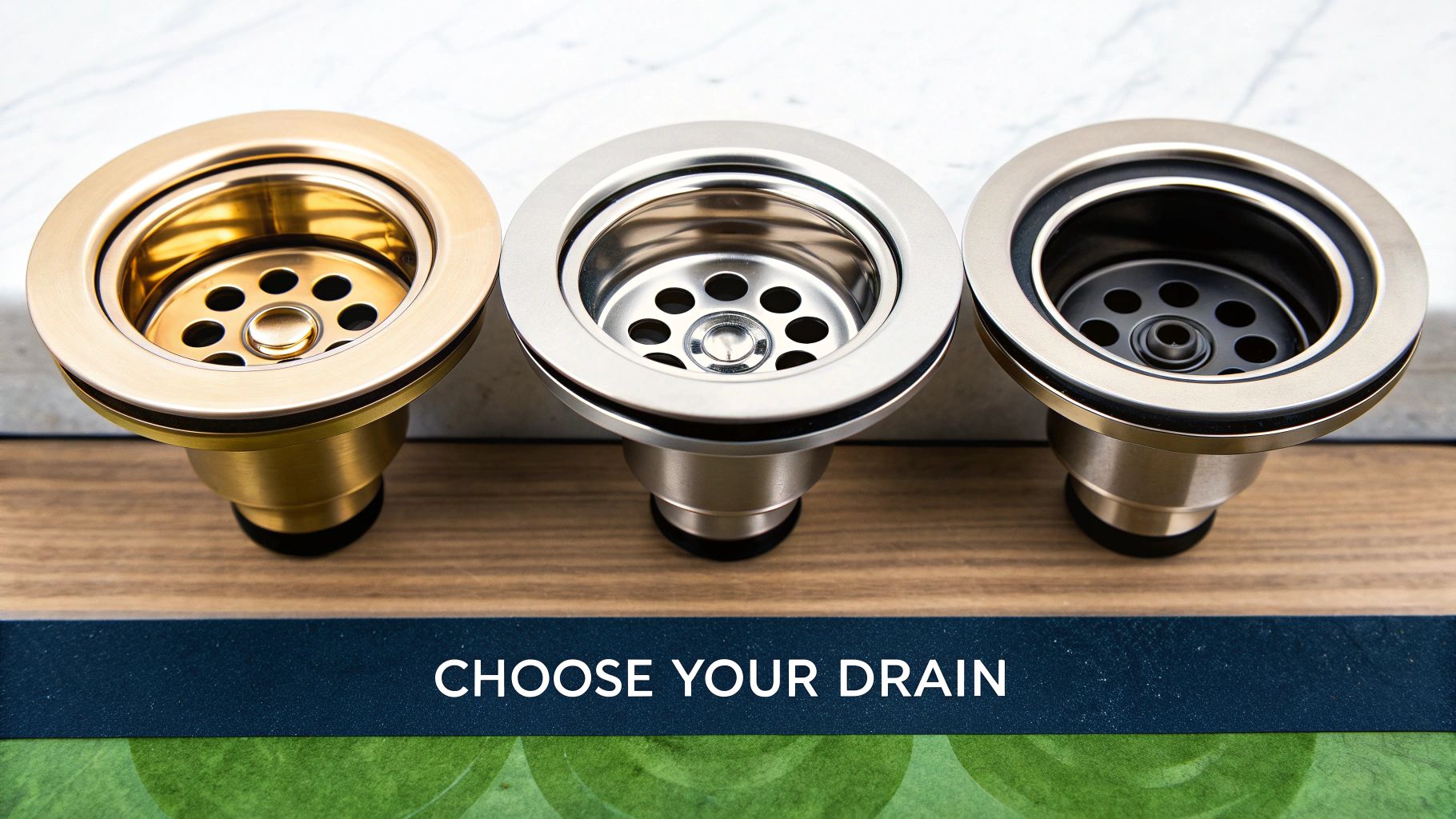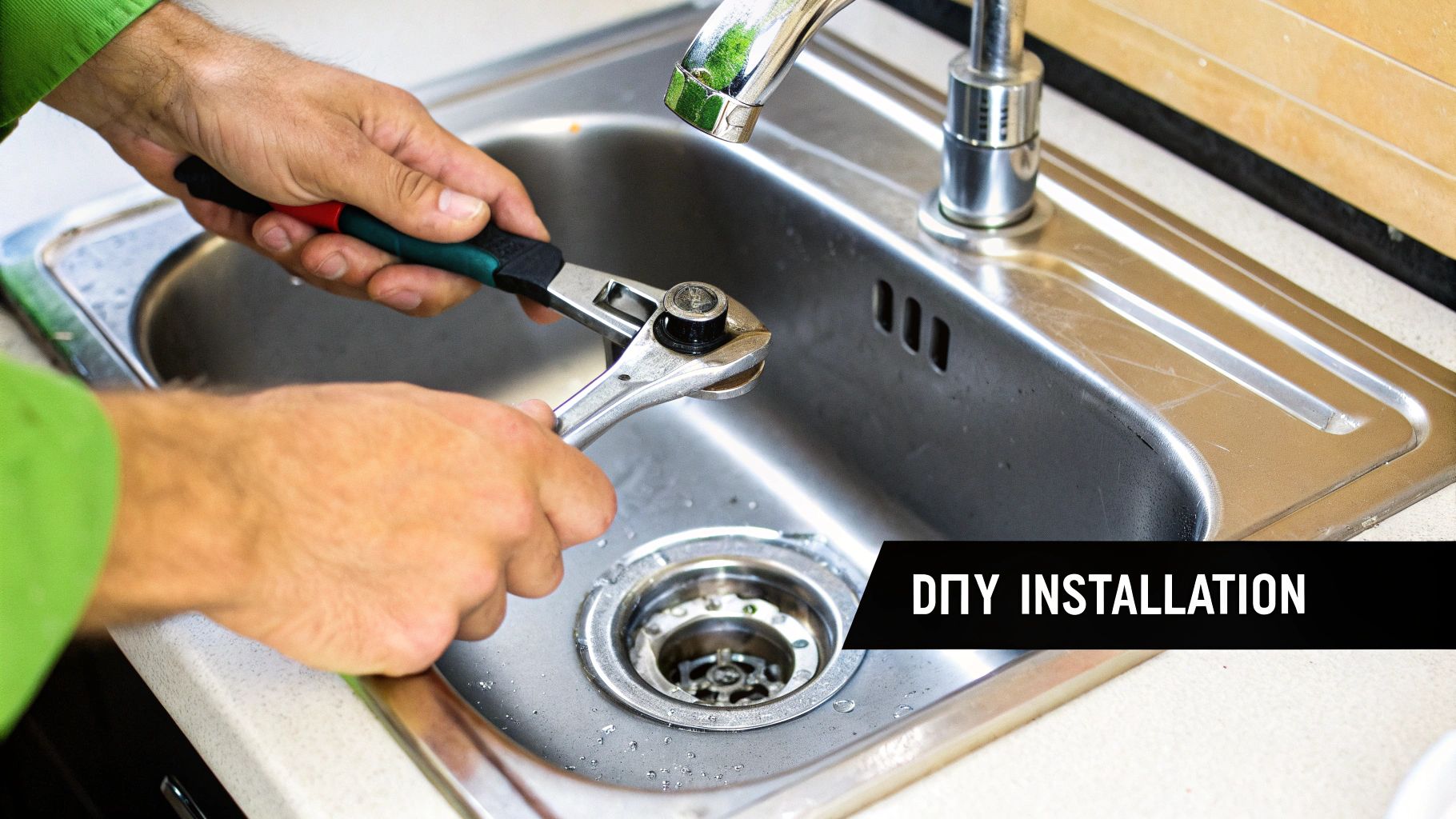
The Ultimate Stainless Steel Sink Drain Guide
Share
A stainless steel sink drain is the hardworking fitting that connects your sink basin to the plumbing pipes hiding underneath. It's the gateway to your whole drainage system, responsible for managing water flow and stopping food scraps from creating a nasty clog. While it might seem like a simple part, it's absolutely essential for a clean, functional kitchen.
The Unsung Hero of Your Kitchen Sink
Think of your sink drain as the silent guardian of your kitchen's plumbing. It's one of those components most of us never give a second thought to, yet it’s constantly on the job, directing water and waste away to prevent backups. Without this little piece of engineering, your sink would just be a bowl with nowhere to go.
Its job is simple but critical. Every time you rinse a plate or wash some vegetables, the drain catches the bigger bits while letting the water flow freely. This basic function is your first line of defense against the headache of clogged pipes and expensive plumbing bills. A good drain keeps your kitchen running smoothly.
Key Components of a Sink Drain
Getting to know the parts of your sink drain makes it a lot less mysterious. Each piece has a very specific role to play.
- Strainer Basket: This is the part you can lift out. Its main job is to catch food solids and other gunk, keeping them from going down your pipes and causing trouble.
- Main Body (Flange): This is the metal ring you see sitting inside the sink itself. It creates a secure, watertight seal between the sink basin and the rest of the drain assembly.
- Tailpiece: This is the straight pipe that runs down from the drain's body. It’s the final connector, linking everything to the P-trap and your home’s plumbing system.
This infographic gives you a clear look at how these parts fit together to do their job.

As you can see, each piece is designed to work with the others to give you a leak-free and clog-resistant connection. It’s a small team of parts working together to keep things flowing.
Finding the Right Drain for Your Sink
Not all stainless steel drains are created equal. Think of choosing the right one like picking the perfect tool for a specific job—it has to match the task at hand. The most familiar option you'll see is the classic basket strainer, a real workhorse designed to catch food scraps and other gunk before they can create a nasty blockage. This is the go-to for most standard kitchen sinks where preventing clogs is the main goal.
Of course, not every kitchen has the same needs. If your sink is paired with a garbage disposal, you'll need a totally different piece of hardware: a specialized disposal flange or drain assembly. This type is designed without a strainer basket on purpose, creating a wide-open path for food waste to pass directly into the disposal unit. It’s a non-negotiable component for any sink with a disposal.
Think of it this way: A basket strainer is a gatekeeper, carefully filtering what goes down the drain. A disposal flange, on the other hand, is an open doorway, built for quick and direct access to the garbage disposal.
Comparing Common Drain Styles
Beyond these two main players, other variations exist to tackle more specific jobs. For instance, some drains have extra-deep baskets to hold more debris, which means you're not emptying them out constantly. You might also come across pop-up drains, which are more common in bathrooms but sometimes pop up (pun intended) in bar sinks, using a lever to seal the drain tight.
For commercial kitchens, especially those using a large 3-bay commercial sink, the demands are even higher. These environments need heavy-duty drains built to handle a massive volume of water and waste without backing up.
To help you sort through the options, I've put together a simple table comparing the most common types.
Comparing Stainless Steel Sink Drain Types
This table compares common stainless steel sink drain types based on their features, ideal use cases, and key benefits to help you make an informed choice.
| Drain Type | Primary Function | Best For | Key Feature |
|---|---|---|---|
| Basket Strainer | Catches food debris, prevents clogs | Standard kitchen sinks without a disposal | Removable basket for easy cleaning |
| Disposal Flange | Connects sink to a garbage disposal | Sinks with an installed garbage disposal | Open design for direct waste flow |
| Pop-Up Drain | Seals the sink to hold water | Bathroom or bar sinks | Lever-operated sealing mechanism |
| Grid Drain | Allows water to pass, catches large items | Secondary prep or utility sinks | A simple, non-closing slatted cover |
Ultimately, choosing the right drain comes down to understanding how you use your sink every day.
- For heavy food prep: A deep basket strainer is a lifesaver. It can handle tons of vegetable peels and scraps without needing constant emptying.
- For quick clean-ups with a disposal: A disposal flange isn't just an option; it's the only correct choice for safety and proper function.
- For a secondary bar or prep sink: A standard basket strainer or even a simple grid drain might be all you really need.
Matching the drain to your sink's function is the key to an efficient, trouble-free kitchen. It's a small detail that makes a huge difference in performance and longevity.
How to Choose the Perfect Sink Drain

Picking out the right stainless steel sink drain goes way beyond just aesthetics. It’s really about getting a perfect, leak-free seal that will hold up for years. The first step is simple, but absolutely critical: measure your sink's drain opening. The standard for most kitchen sinks is 3.5 inches in diameter, but you should always grab a tape measure and check for yourself before you buy anything.
Next up, you need to think about the material grade. Just because they're all called "stainless steel" doesn't mean they're created equal. Keep an eye out for drains made from 304 stainless steel. This is the gold standard in the industry, and for good reason—it offers fantastic resistance to rust and corrosion, even when you're using harsh cleaning chemicals or dealing with acidic foods.
Matching Materials and Finishes
Now for the fun part: making it look good. You’ll want the finish on your drain to complement your sink and faucet. A brushed finish gives off a modern, softer vibe and does a great job of hiding water spots and fingerprints. On the other hand, a polished finish delivers a bright, mirror-like shine that can really make your sink pop. The goal here is a cohesive, intentional look across all your fixtures.
Beyond looks, the nitty-gritty details matter a lot. Pay close attention to things like the threading type and the length of the tailpiece, which is the pipe that connects the drain to your plumbing. Getting a tailpiece that's too short or too long can quickly turn a simple swap into a major headache.
It’s also smart to think ahead about maintenance. Knowing how to deal with parts like the strainer is key. When the time comes, a good guide on how to replace a kitchen sink strainer can be a real lifesaver.
Think of your sink drain as a long-term investment. Choosing a quality product from the get-go saves you from future headaches like leaks, rust, and having to replace it way too soon.
The demand for high-quality, durable kitchen parts is only growing. In fact, the global water sink market is on track to hit USD 65.8 billion by 2035, and stainless steel is leading that charge because of its sheer durability. This growth just highlights how important it is to pick a top-notch stainless steel drain that meets modern standards for both hygiene and longevity. Taking a little extra time to choose the right components will ensure your kitchen runs smoothly for years to come.
Your Step-by-Step Installation Guide

Putting in a new stainless steel sink drain might feel like a job you should leave to the pros, but honestly, it’s a surprisingly manageable DIY project. All you need are a few basic tools and a bit of patience to get a professional, leak-free seal. Let’s walk through it together.
Before diving in, get your supplies lined up: the new drain assembly, some channel-lock pliers, and a roll of plumber's putty. And a quick safety tip—stick a bucket under the sink. It'll catch any water still hanging out in the P-trap.
Removing the Old Drain
First things first, we need to get that old drain out of there. Start by loosening the slip nuts connecting the drain's tailpiece to the P-trap underneath the sink. Once that's free, you can tackle the large locknut holding the drain body tight against the sink basin. This part can be a little stubborn, especially if it’s been there a while, but a solid grip with your pliers will get it done.
With the locknut off, just give the old drain a push from below, and it should pop right out. Now, take a moment to scrape away any old putty or gunk from the sink’s surface. You want a perfectly clean slate for the new drain.
A classic mistake is rushing this part and not cleaning the sink opening properly. Any leftover gunk can mess with the new seal and cause those slow, annoying leaks nobody wants to deal with later.
Installing the New Drain Assembly
Alright, time for the main event. Grab a bit of plumber's putty and roll it between your hands to create a thin rope, about as thick as a pencil. Gently press this rope around the underside of your new drain flange.
- Set the Flange: From inside the sink, push the new drain flange down firmly into the opening. You should see the putty squeeze out evenly all around the edges—that’s your sign you've made a great seal.
- Attach Gaskets and Locknut: Now, head back under the sink. Slide the rubber gasket and friction ring onto the drain body, then thread on the locknut. Hand-tighten it for now to keep everything in position.
- Tighten Securely: Grab your channel-lock pliers and give that locknut a final quarter-turn. It's important not to over-tighten here; you could crack the drain body or even damage the sink itself.
- Connect the Plumbing: Almost there. Attach the tailpiece to the bottom of the new drain and hook it back up to the P-trap, making sure to tighten the slip nuts. For commercial kitchens, it’s crucial to manage waste properly, and you can learn more about how to installing a kitchen grease trap to complete your setup.
Once it's all connected, wipe away the extra putty that squeezed out inside the sink. Turn on the water, let it run for a couple of minutes, and do a thorough check underneath for any signs of leaks. Just like that, you’ve successfully installed your new drain.
Keeping Your Drain Clean and Clog-Free
Let’s be honest, dealing with a clogged sink drain is a headache nobody wants. The good news? Keeping your stainless steel sink drain clear is way easier than you think. A few simple, consistent habits are all it takes to keep water flowing and prevent nasty grime from building up in the first place.
A fantastic starting point is a quick weekly cleaning ritual using stuff you probably already have. Just pour about half a cup of baking soda down the drain, followed by the same amount of white vinegar. You’ll see it fizz and bubble—that’s the magic happening. Let it sit for about ten minutes, then flush it all out with hot water. It's a natural, effective way to dissolve grease and get rid of odors without resorting to harsh chemical cleaners.
Preventing clogs is about creating good habits. Think of it like brushing your teeth—a little daily effort stops bigger problems from developing later on. Small actions, like scraping plates thoroughly, make a huge difference.
Smart Preventative Habits
On top of a weekly flush, a few daily practices will go a long way in keeping your drain in top shape. These small adjustments are all about stopping clogs before they even have a chance to form.
- Scrape Plates Clean: Always scrape leftover food into the trash or compost before rinsing plates in the sink. Even tiny scraps can collect and cause a blockage over time.
- Use a Strainer: Keep that little strainer basket in place. It’s your first line of defense for catching any debris you might miss. Just be sure to empty it regularly.
- Avoid Grease: This is a big one. Never, ever pour cooking grease or oil down the sink. As it cools, it solidifies inside your pipes, creating a sticky trap for everything else.
It's no surprise that the market for sink drains is growing—it's expected to hit around $5 billion by 2025. This tells us that people are actively looking for fixtures that are not only high-performing but also simple to maintain. Durability and easy upkeep are what modern homeowners value.
For more great tips on keeping your whole sink area looking pristine, check out our guide on how to clean stainless steel. And for an even deeper dive into drain care, we highly recommend a comprehensive guide on how to keep your drains clear for some expert-level advice.
Why Stainless Steel is King in the Kitchen
Think of your stainless steel sink drain for a moment. It's not just a random part; it's a small piece of a much bigger idea in kitchen design—an idea built on strength, hygiene, and that clean, professional look we all recognize. The very things that make stainless steel perfect for your drain are the same reasons it’s become the go-to material for hardworking kitchens everywhere, from five-star restaurants to your home. It doesn't rust, it's tough as nails, and it’s a breeze to clean.
This love for stainless steel helps create a kitchen that just works. The clean lines of your sink drain and faucet blend right in with other workhorse equipment, especially the various types of stainless steel prep tables available. These tables are the unsung heroes of any serious kitchen, providing a durable, non-porous surface that won't soak up odors, stain, or give bacteria a place to hide.
Specialized Tables for a Smoother Workflow
Beyond a simple, flat-top workbench, stainless steel is the backbone for more specialized gear built to handle specific jobs and keep a busy kitchen moving efficiently.
- Work Tables: The most basic form, these offer a simple, sturdy surface for chopping, mixing, and general prep. Many come with an undershelf for extra storage.
- Equipment Stands: Designed to hold heavy countertop equipment like mixers or griddles, these stands are built for maximum stability and durability.
- Sandwich Prep Tables: These units feature a refrigerated base with a top section full of chilled pans for meats, cheeses, and veggies. This keeps everything cold and within reach for rapid sandwich assembly.
- Pizza Prep Tables: Similar to sandwich tables, these often have a wider, cooled work surface—typically marble or stainless steel—perfect for stretching pizza dough.
It's all about creating a "kitchen ecosystem." When your sink, prep tables, and appliances are all made of stainless steel, they don't just look good together—they work together. The whole setup is designed for cleanliness, efficiency, and a long life.
And it’s not just a niche trend; the demand for this kind of durable equipment is growing worldwide. The stainless steel sink market alone was valued at a whopping USD 1,385.46 million in 2024 and is on the rise. This reflects a bigger shift toward professional-grade materials in kitchens of all sizes. You can get more details on this market growth at congruencemarketinsights.com. So, when you choose a stainless steel sink drain, you're not just buying a part; you're buying into a standard of quality built to perform.
A Few Common Questions About Sink Drains
When you're dealing with a stainless steel sink drain, a few questions tend to pop up. Let's walk through some of the most common ones to make sure your purchase and installation go smoothly, setting your kitchen up for success.
What Size Drain Do I Need?
This is probably the number one question we hear. For almost every kitchen sink here in the U.S., the standard drain opening is a neat 3.5 inches in diameter. But, and this is important, you should always double-check. Grab a tape measure and confirm your sink's specific opening before you buy anything. It’s a quick step that guarantees a perfect fit.
Will a Garbage Disposal Fit?
Another big one is about connecting a garbage disposal. People often ask, "Can I hook up a disposal to any drain?" The short answer is no. You absolutely need a special disposal flange, not your everyday basket strainer.
A basket strainer is designed to catch debris and will just block waste from getting into the disposal unit. A disposal flange, however, is built for a direct, clear path for food scraps to flow right through.
How Do I Clean It Without Causing Scratches?
Finally, let's talk about keeping that drain looking sharp. The key is to be gentle.
Stay away from abrasive cleaners or steel wool—they will scratch the finish in a heartbeat. Instead, try a simple paste of baking soda and water applied with a soft cloth. It works wonders. For a deeper clean, you can use a mix of baking soda and vinegar, then flush it all down with hot water. This will clear out any gunk safely and effectively.
Getting these small details right makes a huge difference. You'll end up with a sink area that not only works perfectly but also looks fantastic for years to come.
For professional-grade kitchen equipment that holds up just as well as your sink, check out the huge selection of NSF-certified work tables and refrigeration units at PrepTables.com. You can find the perfect setup for your workspace at https://preptables.com.
